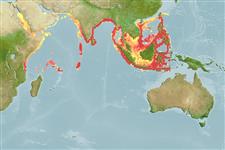Common names from other countries
Environment: milieu / climate zone / depth range / distribution range
Ecología
marino; agua dulce; salobre demersal; anfidromo (Ref. 51243); rango de profundidad 10 - 961 m (Ref. 9494). Tropical; 25°N - 10°S, 32°E - 127°E
Indo-West Pacific: Malay Archipelago including Thailand, Viet Nam, the Philippines and Indonesia westward to seas and estuaries of India and Pakistan to the Red Sea (Ref. 9895).
Length at first maturity / Tamaño / Peso / Age
Maturity: Lm 10.8, range 9 - 12.2 cm
Max length : 45.0 cm TL macho / no sexado; (Ref. 11298); common length : 25.0 cm TL macho / no sexado; (Ref. 9895)
Espinas dorsales (total): 0; Radios blandos dorsales (total): 126-138; Espinas anales 0; Radios blandos anales: 97 - 114; Vértebra: 57 - 66.
Adults live mainly in shallow muddy and sandy bottoms of the continental shelf, sometimes entering estuaries and tidal rivers (Ref. 1479, 48637). Usually deeply buried in the substrate during the day, but out and hunting at night (Ref. 48637). They feed mainly on benthic invertebrates. Marketed mostly fresh and frozen; also dried-salted (Ref. 9895).
Menon, A.G.K., 1977. A systematic monograph of the tongue soles of the genus Cynoglossus Hamilton-Buchanan (Pisces: Cynoglossidae). Smithson. Contrib. Zool. (238):1-129. (Ref. 5297)
IUCN Red List Status (Ref. 130435)
CITES (Ref. 128078)
Not Evaluated
Threat to humans
Harmless
Human uses
Pesquerías: comercial
Herramientas
Special reports
Download XML
Fuentes de Internet
Estimates based on models
Preferred temperature (Ref.
115969): 8.8 - 18.2, mean 12.3 (based on 243 cells).
Phylogenetic diversity index (Ref.
82804): PD
50 = 0.5000 [Uniqueness, from 0.5 = low to 2.0 = high].
Bayesian length-weight: a=0.01514 (0.00592 - 0.03870), b=3.00 (2.77 - 3.23), in cm Total Length, based on LWR estimates for this (Sub)family-body shape (Ref.
93245).
Nivel trófico (Ref.
69278): 3.5 ±0.37 se; based on food items.
Resiliencia (Ref.
120179): Medio, población duplicada en un tiempo mínimo de 1.4-4.4 años (Fec = 360-35,926).
Fishing Vulnerability (Ref.
59153): Low to moderate vulnerability (35 of 100).
